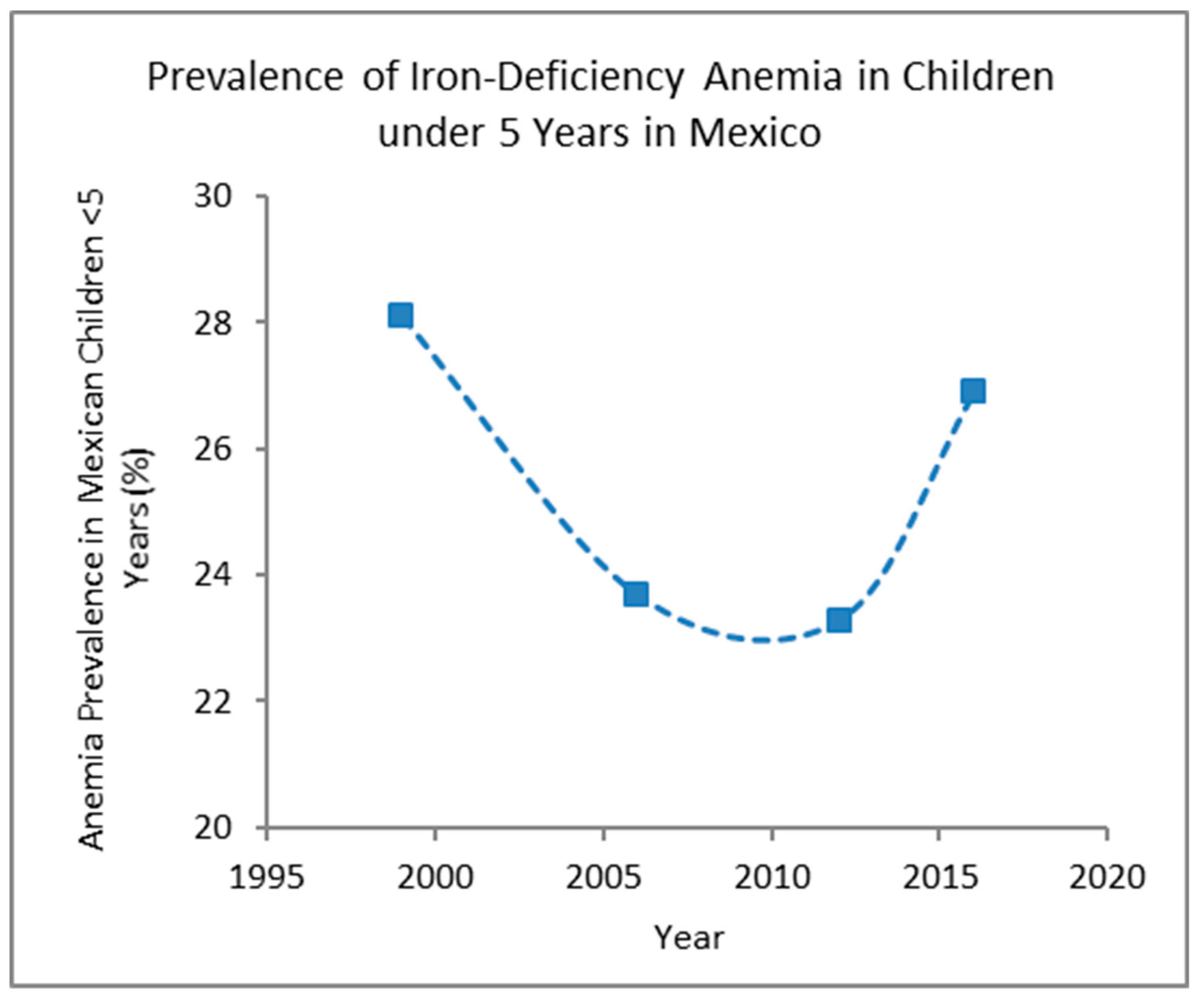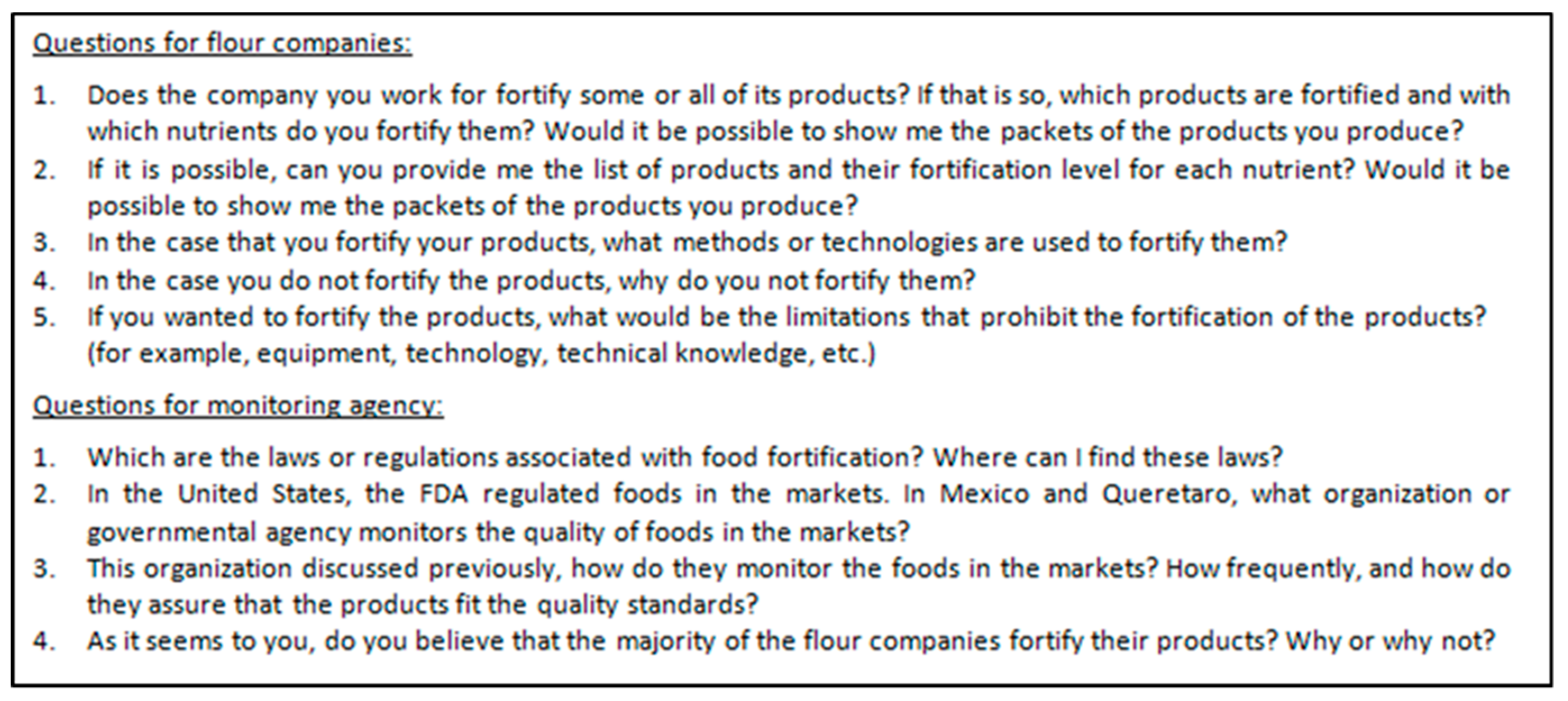Stakeholder’s Perceptions of Mexico’s Federal Corn Flour Fortification Program: A Qualitative Study
Abstract
1. Introduction
2. Materials & Methods
2.1. Qualitative Research Approach
2.2. Phase 1: Participant Recruitment
2.3. Phase 2: In-Depth Interviews with Stakeholders
2.4. Phase 3: Thematic Analysis
3. Results
3.1. Monitoring Logistics
3.1.1. External Monitoring Capacity
3.1.2. Frequency of External Regulatory Audits
3.1.3. Variation in External Regulatory Audit Processes
“During the visits we review the addition of micronutrients. We have a NOM 251 that speaks of all Good Manufacturing Practices. We monitor everything that is the facilities, the process water, the drainage, the toilets, the ventilation… We also check the warehouse with special attention to the storage of flour that has been added and the premix, and so all this is documented. Then in the warehouse they must have a record of inputs and outputs”.
3.1.4. Internal Monitoring Capacity
3.2. Manufacturing and Processing
Preparation of Tortillas
“It [the flour] is added with softener, bleach, and some substance that serves to give strength or that does not break the tortilla when you make a taco. But, we are removing [decreasing the use of] those flours, to give a little texture, or softness to the tortilla. Why have we reduced the consumption of flour? First, we find it is more expensive to produce tortillas with flour than we do our own nixtamal… Without using a lot of corn [fortified] flour, we already have the softness, we have a very good texture, we have very good resistance of the tortilla to make a taco”.
3.3. Nutrition
3.3.1. Limited Evaluation of the Fortification Program’s Impact on Health
“We have not measured the contribution [the fortification program] on the health of the population. However, we believe that it is contributing [to their health] since the entire population practically consumes this, be it bread or tortilla”.
3.3.2. Limited Impact Divided by Geographic Location and Socioeconomic Status
“The fortification programs are for the population that has significant nutritional deficiencies. Our product is fortified because it is mandatory. But our product does not normally go to the population [that needs it], but to a higher purchasing sector”.
3.3.3. Diets of the Mexican Population
“We, as Mexicans, have changed our diet, we have stopped eating tortillas. We should see the consequences that this change in diet has had on these problems [micronutrient deficiencies] that are occurring”.
4. Discussion
4.1. Monitoring Logistics Theme
“12. Compliance with the standard12.1. The monitoring of the application of this rule corresponds to the Ministry of Health in the terms and applicable legal provisions”.
4.2. Manufacturing and Processing Theme
4.3. Nutrition Theme
4.4. Recommendations
Author Contributions
Funding
Conflicts of Interest
Abbreviations
| ASSURED | (Affordable, Sensitive, Specific, User-friendly, Rapid and robust, Equipment-free, Deliverable) |
| COFEPRIS | (Mexico’s Federal Commission for Protection against Health Risks) |
| ENSANUT | (Mexico’s National Health and Nutrition Survey) |
| ICC | (Intraclass Correlation Coefficient) |
| NOM | (Norma Oficial Mexicana) |
| WHO | (World Health Organization) |
| IDA | (Iron-Deficiency Anemia) |
References
- Allen, L.H.; De Benoist, B.; Dary, O.; Hurrell, R. Guidelines on Food Fortification with Micronutrients; WHO Press: Geneva, Switzerland, 2006. [Google Scholar]
- Horton, R. Maternal and child undernutrition: An urgent opportunity. Lancet 2008, 371, 179. [Google Scholar] [CrossRef]
- World Health Organization. Vitamin and Mineral Nutrition Information System (VMNIS). 1995. Available online: https://www.who.int/vmnis/en/ (accessed on 1 August 2019).
- World Health Organization. Iron Deficiency Anaemia: Assessment, Prevention and Control: A Guide for Programme Managers; WHO Press: Geneva, Switzerland, 2001. [Google Scholar]
- World Health Organization. Iodine Status Worldwide: WHO Global Database on Iodine Deficiency; WHO: Geneva, Switzerland, 2004; pp. 1–58. [Google Scholar]
- World Health Organization. Global Prevalence of Vitamin a Deficiency in Populations at Risk 1995–2005; WHO Global Database on Vitamin A Deficiency: Geneva, Switzerland, 2009. [Google Scholar]
- Shamah-Levy, T.; Villalpando, S.; Mundo-Rosas, V.; De, V.C.-G.; Mejía-Rodríguez, F.; Méndez, I.G.-H. Prevalence of anemia in reproductive-age Mexican women. Salud Pública México 2013, 55, S190–S198. [Google Scholar] [CrossRef]
- Villalpando, S.; Mundo-Rosas, V.; Shamah-Levy, T. Prevalence of anemia in Mexican children and adolescents: Results from three national surveys. Salud Publica Mex. 2013, 55, S180–S189. [Google Scholar]
- Rivera, J.A.; Irizarry, L.M.; González-de Cossío, T. Overview of the nutritional status of the Mexican population in the last two decades. Salud Publica Mex. 2009, 51, S645–S656. [Google Scholar] [CrossRef]
- de la Cruz-Góngora, V.; Villalpando, S.; Shamah-Levy, T. Prevalencia de anemia y consumo de grupos de alimentos en niños y adolescentes mexicanos: Ensanut MC 2016. Salud Pública México 2018, 60, 291–300. [Google Scholar] [CrossRef]
- De Benoist, B.; Cogswell, M.; Egli, I.; McLean, E. Worldwide Prevalence of Anaemia 1993–2005; WHO Global Database of Anaemia: Geneva, Switzerland, 2008. [Google Scholar]
- Guideline, W. Fortification of Maize Flour and Corn Meal with Vitamins and Minerals; World Health Organization: Geneva, Switzerland, 2016. [Google Scholar]
- Paredes López, O.; Guevara Lara, F.; Bello Pérez, L.A. La nixtamalización y el valor nutritivo del maíz. Ciencias 2009, 92. [Google Scholar]
- Gasca-Mancera, J.; Casas-Alencáster, N. Adición de harina de maíz nixtamalizado a masa fresca de maíz nixtamalizado. Efecto en las propiedades texturales de masa y tortilla. Revista Mexicana de Ingeniería Química 2007, 6, 317–328. [Google Scholar]
- NORMA Oficial Mexicana. NOM-247-SSA1-2008, Productos y Servicios. Cereales y sus Productos. Cereales, Harinas de Cereales, Sémolas o Semolinas. Alimentos a Base de: Cereales, Semillas Comestibles, de Harinas, Sémolas o Semolinas o sus Mezclas. Productos de Panificación. Disposiciones y Especificaciones Sanitarias y Nutrimentales. 2008. Available online: http://depa.fquim.unam.mx/amyd/archivero/NOMcereales_12434.pdf (accessed on 7 February 2020).
- PROFECO. Acciones y Programas: Gob.mx. Available online: https://www.gob.mx/profeco#2237 (accessed on 1 August 2019).
- Chauvet, M.; González, R.L. Globalización y estrategias de grupos empresariales agroalimentarios de México. Comer. Exter. 1999, 49, 745–754. [Google Scholar]
- Quintana, S.; Víctor, M. Crisis de la Tortilla, Crisis del Modelo. 2007. Available online: http://colombiareport.ss.uci.edu/webdocs/crisisdelatortilla.pdf (accessed on 7 February 2020).
- Luthringer, C.L.; Rowe, L.A.; Vossenaar, M.; Garrett, G.S. Regulatory Monitoring of Fortified Foods: Identifying Barriers and Good Practices. Global Health: Sci. Pract. 2015, 3, 446–461. [Google Scholar] [CrossRef]
- Neufeld, L.M.; Baker, S.; Garrett, G.S.; Haddad, L. Coverage and Utilization in Food Fortification Programs: Critical and Neglected Areas of Evaluation. J. Nutr. 2017, 147, 1015S–1019S. [Google Scholar] [CrossRef] [PubMed]
- Uauy, R.; Hertrampf, E.; Reddy, M. Iron fortification of foods: Overcoming technical and practical barriers. J. Nutr. 2002, 132, 849S–852S. [Google Scholar] [CrossRef] [PubMed]
- Waller, A.W.; Lotton, J.L.; Gaur, S.; Andrade, J.M.; Andrade, J.E. Evaluation of Micronutrient Sensors for Food Matrices in Resource-Limited Settings: A Systematic Narrative Review. J. Food Sci. 2018, 83, 1792–1804. [Google Scholar] [CrossRef] [PubMed]
- Peeling, R.; Holmes, K.; Mabey, D.; Ronald, A. Rapid tests for sexually transmitted infections (STIs): The way forward. Sex. Transm. Infect. 2006, 82, V1–V6. [Google Scholar] [CrossRef]
- Waller, A.W.; Toc, M.; Rigsby, D.J.; Gaytán-Martínez, M.; Andrade, J.E. Development of a Paper-Based Sensor Compatible with a Mobile Phone for the Detection of Common Iron Formulas Used in Fortified Foods within Resource-Limited Settings. Nutrients 2019, 11, 1673. [Google Scholar] [CrossRef]
- Tong, A.; Sainsbury, P.; Craig, J. Consolidated criteria for reporting qualitative research (COREQ): A 32-item checklist for interviews and focus groups. Int. J. Qual. Health Care 2007, 19, 349–357. [Google Scholar] [CrossRef]
- Brugha, R.; Varvasovszky, Z. Stakeholder analysis: A review. Health Policy Plan. 2000, 15, 239–246. [Google Scholar] [CrossRef]
- Harris, J.E.; Gleason, P.M.; Sheean, P.M.; Boushey, C.; Beto, J.A.; Bruemmer, B. An introduction to qualitative research for food and nutrition professionals. J. Am. Diet. Assoc. 2009, 109, 80–90. [Google Scholar] [CrossRef]
- Rowley, J. Conducting research interviews. Manag. Res. Rev. 2012, 35, 260–271. [Google Scholar] [CrossRef]
- Braun, V.; Clarke, V. Using thematic analysis in psychology. Qual. Res. Psychol. 2006, 3, 77–101. [Google Scholar] [CrossRef]
- Muhr, T. Atlas.ti Version 8.1. Berlin, Germany: ATLAS.ti Scientific Software Development GmbH; Atlas.ti: Berlin, Germany, 2017. [Google Scholar]
- IBM Corp. Ibm Spss Statistics for Windows, Version 24.0; IBM Corp: Armonk, NY, USA, 2016. [Google Scholar]
- Koo, T.; Li, M. A Guideline of Selecting and Reporting Intraclass Correlation Coefficients for Reliability Research. J. Chiropr. Med. 2016, 15, 155–163. [Google Scholar] [CrossRef] [PubMed]
- Mantilla, R.; Fernando, R.; Torres Sanabria, G.; Garrido Roldán, S. Un modelo econométrico de la demanda de tortilla de maíz en México, 1996–2008. Estud. Soc. (Hermosillo Son) 2014, 22, 37–59. [Google Scholar] [CrossRef]
- Bhutta, Z.A.; Ahmed, T.; Black, R.E.; Cousens, S.; Dewey, K.; Giugliani, E.; Haider, B.A.; Kirkwood, B.; Morris, S.S.; Sachdev, H.P.S.; et al. What works? Interventions for maternal and child undernutrition and survival. Lancet 2008, 371, 417–440. [Google Scholar] [CrossRef]
- Johnson, Q.W.; Wesley, A.S. Miller’s best/enhanced practices for flour fortification at the flour mill. Food Nutr. Bull. 2010, 31, S75–S85. [Google Scholar] [CrossRef]
- Nichols, E.; Aburto, N.; Masa’d, H.; Wirth, J.; Sullivan, K.; Serdula, M. Performance of iron spot test with Arabic bread made from fortified white wheat flour. Food Nutr. Bull. 2012, 33, 202–206. [Google Scholar] [CrossRef]
- Rentería-Gómez, I.; Santiago, M.A.L.; Domínguez-Pacheco, F.A.; Hernández-Aguilar, C.; Zepeda-Bautista, R. Evaluation of the profitability of the production of corn tortilla in the State of Mexico Evaluación de la rentabilidad de la producción de tortilla de maíz en el Estado de México. Rev. Chapingo Ser. Zonas Arid. 2018, 17, 1–13. [Google Scholar]
- Shamah-Levy, T.; Mejía-Rodríguez, F.; Méndez Gómez-Humarán, I.M.; Cruz-Góngora, V.D.L.; Mundo-Rosas, V.; Villalpando-Hernández, S. Tendencia en la prevalencia de anemia entre mujeres mexicanas en edad reproductiva 2006-2016. Ensanut MC 2016. Salud Pública México 2018, 60, 301–308. [Google Scholar] [CrossRef]
- Andang’o, P.E.A.; Osendarp, S.J.M.; Ayah, R.; West, C.E.; Mwaniki, D.L.; De Wolf, C.A.; Kraaijenhagen, R.; Kok, F.J.; Verhoef, H. Efficacy of iron-fortified whole maize flour on iron status of schoolchildren in Kenya: A randomised controlled trial. Lancet 2007, 369, 1799–1806. [Google Scholar] [CrossRef]
- Shamah-Levy, T.; Villalpando-Hernández, S.; García-Guerra, A.; Mundo-Rosas, V.; Mejía-Rodríguez, F.; Domínguez-Islas, C.P. Anemia in Mexican women: Results of two national probabilistic surveys. Salud Ública México 2009, 51, S515–S522. [Google Scholar] [CrossRef]
- Park, S.-H.; Kwak, T.-K.; Chang, H.-J. Evaluation of the food safety training for food handlers in restaurant operations. Nutr. Res. Pract. 2010, 4, 58–68. [Google Scholar] [CrossRef]
- Rothschild, M.L. Carrots, sticks, and promises: A conceptual framework for the management of public health and social issue behaviors. J. Mark. 1999, 63, 24–37. [Google Scholar] [CrossRef]
- Rivera, J.A.; Sotres-Alvarez, D.; Habicht, J.P.; Shamah, T.; Villalpando, S. Impact of the Mexican program for education, health, and nutrition (Progresa) on rates of growth and anemia in infants and young children: A randomized effectiveness study. JAMA 2004, 291, 2563–2570. [Google Scholar] [CrossRef] [PubMed]



© 2020 by the authors. Licensee MDPI, Basel, Switzerland. This article is an open access article distributed under the terms and conditions of the Creative Commons Attribution (CC BY) license (http://creativecommons.org/licenses/by/4.0/).
Share and Cite
Waller, A.W.; Dominguez-Uscanga, A.; Lopez Barrera, E.; Andrade, J.E.; Andrade, J.M. Stakeholder’s Perceptions of Mexico’s Federal Corn Flour Fortification Program: A Qualitative Study. Nutrients 2020, 12, 433. https://doi.org/10.3390/nu12020433
Waller AW, Dominguez-Uscanga A, Lopez Barrera E, Andrade JE, Andrade JM. Stakeholder’s Perceptions of Mexico’s Federal Corn Flour Fortification Program: A Qualitative Study. Nutrients. 2020; 12(2):433. https://doi.org/10.3390/nu12020433
Chicago/Turabian StyleWaller, Anna W., Astrid Dominguez-Uscanga, Emely Lopez Barrera, Juan E. Andrade, and Jeanette M. Andrade. 2020. "Stakeholder’s Perceptions of Mexico’s Federal Corn Flour Fortification Program: A Qualitative Study" Nutrients 12, no. 2: 433. https://doi.org/10.3390/nu12020433
APA StyleWaller, A. W., Dominguez-Uscanga, A., Lopez Barrera, E., Andrade, J. E., & Andrade, J. M. (2020). Stakeholder’s Perceptions of Mexico’s Federal Corn Flour Fortification Program: A Qualitative Study. Nutrients, 12(2), 433. https://doi.org/10.3390/nu12020433





